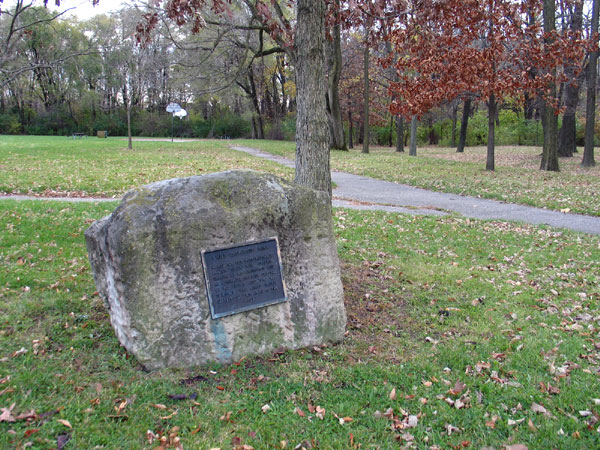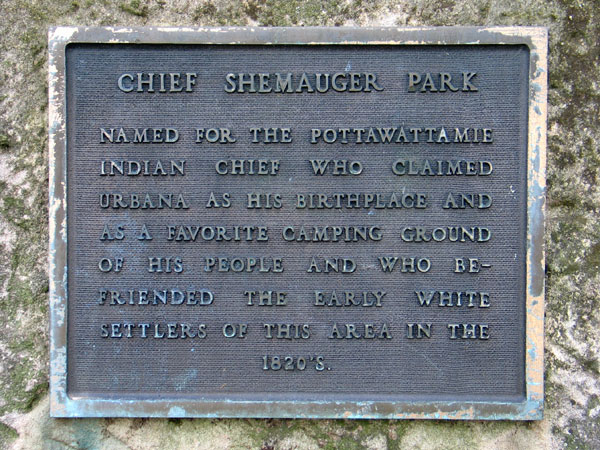Our early settlers around and in these timber belts and groves well remember many of their Indian visitors by name, and the writer has listened with great interest to many enthusiastically told stories from them of personal contact with these people. Particular mention was made by many of a Pottawattamie chief named Shemauger, who was also known by the name of Old Soldier. Shemauger often visited the site or Urbana after the whites came, and for some years after 1824. He claimed it as his birthplace, and told the early settlers that the family home at the time of his birth was near a large hickory tree then growing upon a spot north of Main Street and a few rods west of Market Street. He professed great love for this location as his birthplace, and the camping ground of his people for many years. At the time of the later visits of Shemauger there was not only the hickory tree, but a large wild cherry tree standing about where the hall of the Knights of Pythias is now situated. Besides these trees there were others in the neighborhood of the creek, which made this a favorite and most convenient and comfortable camping place for the Indians; and, from what is known of the habits of these people, it is not improbable that the chief was correct in the claim made upon Urbana as his birthplace. It is remembered of Shemauger that he would sometimes come in company with a large retinue of his tribe and sometimes with his family only, when he would for months in camp at points along the creek. In the winter of 1831-32, these Indians to the number of fifteen or twenty remained in their camp near the big spring on what, of later years, has been known as the Stewart farm in the neighborhood of Henry Dobson's about two miles north of Urbana.

Another favorite camping ground of Shemauger was at a point known as the Clay Bank on the northwest quarter of Section 2, Urbana Township, sometimes called Clement's Ford, towards the north end of the Big Grove. One early settler (Amos Johnson, who died twenty years since) related to the writer his observations of these people while there in camp. His father occupied a cabin not far away, and the family paid frequent visits to the camp out of curiosity, fearing nothing. Some of the braves amused themselves by cutting with their tomahawks mortices into contiguous trees, into which mortices they inserted poles cut the proper lengths. These poles, so placed horizontally at convenient distances from each other, made a huge living ladder reaching from the ground to a great height. Up this ladder the Indians would climb when the weather was warm and sultry to catch the breezes and to escape the annoyances of the mosquitoes. He saw the bucks thus comfortably situated upon a scaffold in the tops of the trees, while their squaws were engaged in the domestic duties of the camp on the ground below. Thirty-five or more years ago, trees from near the Clay Bank were cut and sawed into lumber at the nearby mill of John Smith, when these mortices, overgrown by many years' growth of the trees, were uncovered, showing the work of these Indians forty years before, and corroborating the story as related to the writer.
Shemauger told another early settler (James W. Boyd, who died many years since), or in his hearing, that many years before, there came in this country a heavy fall of snow, the depth of which he indicated by holding his ramrod horizontally above his head, and said that many wild beasts, elk, deer and buffalo perished under the snow. To this fact, within his knowledge, he attributed the presence of many bones of animals then seen on the prairies.

Shemauger was remembered by those who knew him personally as a very large, bony man, always kind and helpful to the white settlers. It was also said that, upon being asked to do so, he would, with a company of followers, attend the cabin raisings of the early settlers and assist them in the completion of their cabin homes. All accounts of Shemauger represent him as kind to the whites and ambitious for the elevation of his people. One early settler (Jesse B. Webber) at the Big Grove, who came here in 1830 and remained all of that winter before making himself a home, spent much of his time in the company of the chief and formed for him a high esteem. In 1830 Shemauger was about seventy-five years of age and had, in his time, participated in many of the Indian wars with the whites and, with his experience, would gladly remain at peace with them. The Kankakee Valley was the home of the chief during the last years of his stay in Illinois, and he was seen there by those who made trips to Chicago. Following the Black Hawk War his tribe - or the remnant of it remaining east of the Mississippi River - went West and its members were seen here no more. (642-43)
History of Champaign County (1905)
J.O. Cunningham